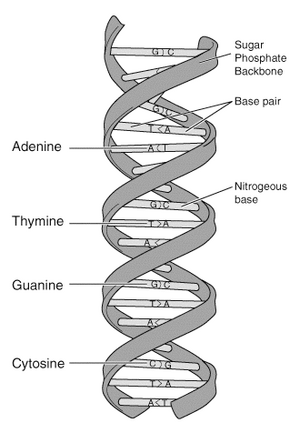Molecular Structure of Nucleic Acids: A Structure for Deoxyribose Nucleic Acid facts for kids
The article "Molecular Structure of Nucleic Acids: A Structure for Deoxyribose Nucleic Acid" was a very important scientific paper. It was the first to describe the amazing double helix shape of DNA. This discovery was made using a special technique called X-ray diffraction and some clever math. Francis Crick and James D. Watson wrote this paper. It was published in the science magazine Nature on April 25, 1953.
Many people call this article a "pearl" of science. This is because it was short but answered a huge question about living things. The big mystery was: How do living organisms store their genetic instructions? And how do they pass these instructions from parents to their children? The paper offered a simple and beautiful answer. Many scientists at the time were surprised because they thought understanding DNA would be much harder. This discovery changed biology forever, especially the study of genetics. It helped scientists later figure out the genetic code, which is like a secret language of life.
Understanding DNA: The Blueprint of Life
The study of how physics and chemistry apply to living things led to a field called molecular biology. This science looks at how information flows inside living cells, especially from DNA to proteins. When the DNA double helix was discovered, it became clear that genes are specific parts of DNA molecules. It also showed that cells must have a way to read the information in DNA. This information tells them how to make specific amino acids, which are the building blocks of proteins.
Key Scientists in DNA Discovery
Many brilliant minds helped us understand DNA. Here are a few important ones:
- Linus Pauling was a famous chemist. He greatly influenced how we understand the shapes of biological molecules. In 1951, Pauling discovered the structure of the alpha helix. This is a very important part of proteins. In early 1953, Pauling also published a model for DNA, but his idea of a triple helix turned out to be wrong. Both Crick and Watson felt like they were in a race against Pauling to find the correct DNA structure.
- Max Delbrück was a physicist. He saw how ideas from quantum physics could apply to biology. Delbrück's thoughts about the physical basis of life inspired Erwin Schrödinger to write a book called What Is Life? This book was very important to Crick and Watson. Delbrück also helped create the "Phage Group." This group studied genetics using viruses that infect bacteria. This work was key to the early development of molecular biology and especially shaped Watson's scientific interests.
- Francis Crick, James Watson, and Maurice Wilkins were awarded the Nobel Prize for Medicine. They received this honor for their amazing discovery of the DNA double helix structure.
Images for kids
-
DNA replication. The two base-pair complementary chains of the DNA molecule allow replication of the genetic instructions.
-
Watson and Crick used many aluminium templates like this one, which is the single base Adenine (A), to build a physical model of DNA in 1953.




